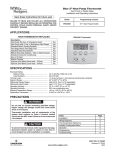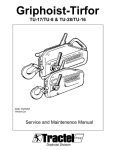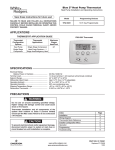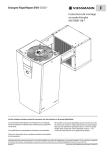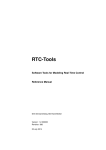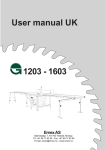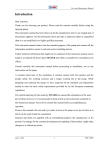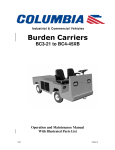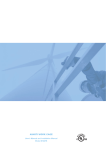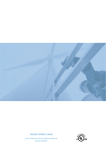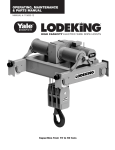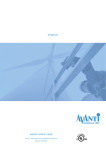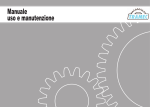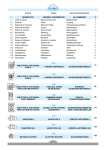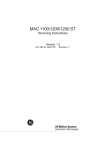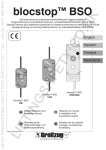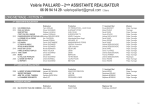Download XE501PA1 Service Manual _111203_Q4.qxd
Transcript
tirak
®
XE501PA1
Date: 10/06/03
Version: 2
Draft: 5
Service & Maintenance Manual
for Electric Powered Hoists
BASIC TROUBLESHOOTING
WARNING
Repair and maintenance of the Tirak hoist should
always be accomplished in a safe environment!
This sheet is to be used by certified Tirak
technicians only!
The purpose of this sheet is for quick reference
only. Most troubleshooting solutions can be
found on pgs. 17 & 18 of the Tirak Instruction
Manual included with each hoist.
PROBLEM
POSSIBLE CAUSE
Low power
Centrifugal switch (stuck closed)
Start capacitor defective
High amps and/or heat
Stator burned
Brake dragging
Water damage
Hoist overloaded
Brake rectifier defective
Run capacitor defective
Hoist frozen electrically (ie. Won't run in either direction)
Brake coil defective
Fuse defective
Hoist goes up but not down
Blocstop has been activated
E-stop button has been activated
Up and/or Down button does nothing
Fuse defective
Centrifugal switch (stuck open) defective
Hoist goes down when up button is pressed
Capacitor (start and/or run)
Start capacitor defective
Hoist will not lift a suspended load
Low power
Slightly higher amps than normal
Run capacitor defective
Main relay coil short circuit
Fuse in control circuit blows immediately
Fuse defective
Thermal protector is shorted
Table 001
2
TABLE OF CONTENTS: TIRAK XE501PA1
Page
1) GENERAL INFORMATION
1-1 UL Listing Card
1-2 Dimensional Information
1-3 Model Identification Table
1-4 Test Certificate
4
5
6
7
2) SECONDARY BRAKE ATTACHMENT
2-1 BSO500 - Secondary Brake
Mounting Parts List
8
3) WIRE ROPE DRIVING SYSTEM
3-1 Introduction
3-2 Tools Required
3-3 Blocstop Removal
3-4 External Inspection
3-5 Casing Cover Removal
3-6 Internal Inspection
3-7 Resassembly
3-8 Casing Cover Installation
3-9 Pressure System Replacement
3-10 Wire Rope Guide Band Replacement
3-11 Radial Packing Ring Replacement
3-12 Sheave Bearing Replacement
3-13 Casing Base Repair- Guideband Area
3-14 Stirrup Bar Modification
3-15 Wire Rope Guide Bolt Retrofit
3-16 Wire Rope Drive System Parts List
9
9
9
9
10
11
14
14
15
17
18
19
19
22
23
24
4) GEARBOX
4-1 Tools Required
4-2 Gearbox Disassembly
4-3 Gearbox Reassembly
4-4 Hoist-Position for Oil Level Inspection
4-5 Gearbox Parts List
5) PRIMARY BRAKE FOR MOTOR
5-1 Brake Types
5-2 Tools Required
5-3 Brake Inspection
5-4 Brake Removal
5-5 Disc Inspection
5-6 Brake Air Gap Adjustment
5-7 Release Stirrup Replacement
5-8 Operational Check
5-9 Brake Coil Resistance Inspection
5-10 Primary Brake Parts List
5-11 Assembly and Adjusting
Page
6) MOTOR
6-1 Replacement of Motor Winding (Stator) 46
6-2 Centrifugal Switch Replacement
50
6-3 Motor Parts List
57
7) CONTROL BOX
7-1 Tools Required
7-2 Control Box Cover Inspection
7-3 Ground (Cord/Plug) Check
7-4 Wiring Diagram and General Condition
of the Control Box
7-5 Stator/Winding Check
7-6 Fuse Check, F1
7-7 Thermal Protector Check
7-8 Relays
7-9 Brake Coil Resistance Check
7-10 Capacitor Checks
7-11 Centrifugal Switch Checks
7-12 Pushbutton Checks
7-13 Control Box Base
7-14 Power Check
7-15 Brake Rectifier Check
7-16 Direct Control 220V Control Box
Parts List XE501PA1
7-17 Pendant Control 220V Control Box
Parts List XE501PA1
59
59
60
60
61
62
62
62
63
64
64
66
67
67
67
68
70
8) WIRING INFORMATION
8-1 Wiring Diagram XE501PA1
72
Direct Control, Plan 14606
8-2 Wiring Diagram XE501PA1
74
Pendant Control, Plan 31007
8-3 Wiring Connection of Stator XE501PA1 76
26
26
30
36
37
9) WIRE ROPE / ADDITIONAL INFORMATION
10-1 Wire Rope Specification Tirak
10-2 Tirak Instruction Manual
10-3 Labels and Nameplates
10-4 Checklist
10-5 Hoist Specification XE501PA1
39
39
40
41
42
43
44
44
45
45
45
77
79
80
81
NOTE:
Throughout the text, parts will be referred to as
codes and positions (e.g stirrup bar, Code
#47867, Pos. 84). These codes and positions
can be found at the end of each chapter in the
“Parts Lists” and “Exploded Views”.
3
1) GENERAL INFORMATION
1-1 UL Listing Card
Northbrook, Ilinois (847) 272- 8800
Melville, New York (631) 271-6200
Santa Clara, California (408) 985-2400
Research Triangle Park,
North Carolina (919) 549-1400
Camas, Washington (360) 817-5500
TRACTEL INC
GRIPHOIST DIV
110 SHAWMUT RD
PO BOX 188
CANTON, MA 02021
TUFV
Equiptment, Scaffolding
April 18, 2002
TRACTEL INC GRIPHOIST DIV
110 SHAWMUT RD PO BOX 188, CANTON MA 02021
SA4785
Electric scaffold hoists, Models ETH-32L, XE301P, maximum load 700 lbs: Models ETH35C, ETH35C3,
ETH35X, LE500P, LE501P, TE401P, -401PA, XE500P, -501P, -501PA, maximum load 1000lbs; Models
TE1000P, -1001P, -1001PA, XE501PO, XE700P, -701P, XE720P, XE721P, maximum load 1500lbs; Models
TE1020P, -1021P, -1021PA, maximum load 2000 lbs; Model XE1020P, maximum load 2400 lbs; Model
XE2050P, maximum load 4400 lbs.
Manually operated scaffold hoists, Model TMS-600, maximum load 1320 lbs; Model TU-17, maximum
load 1500 lbs; Model TU-28, maximum load 3000 lbs; Model TU-32, maximum load 6000 lbs; Model 408, maximum load 880 lbs.
Pneumatic scaffold hoists, Models ATH32L, -32LB, XA300P, -300PB, maximum load 700 lbs; Models
ATH35C ATH35X, -35XB, LA500P, XA500P, -500PB, maximum load 1000 lbs; Models XA700P, -700PB,
XA720PB, maximum load 1500 lbs; Model XA1030PO, maximum load 1850 lbs; Model TA1020P, maximum load
2000 lbs; Model XA1020P, maximum load 2400 lbs; Model XA2050P, maximum load 4400 lbs; Model XA2650P,
maximum load 5300 lbs.
Independent secondary brakes, Model BS15.301, maximum load 1500 lbs; Model BS20.301, maximum
load 3000 lbs; Model BS35.30, maximum load 6000 lbs.
Modular work platform, “Modular Staging”, 2 to 12 m, rated 750 lbs; Models KD01, MP03, 2 to 18m, rated
750 to 1500 lbs; “PFD”, 2 to 15m, load 6000 lbs.
Work Cages, Model PMR0700D, PMR0701D, VSMV-PMR0710D, rated 1000 lbs; Model WC01, rated 400
lbs.
This equipment consists of separate parts inspected at the factory by Underwriters Laboratories Inc. and is
intended for use in complete complete installations. Installations are not inspected by Underwriters Laboratories
Inc. but should be made in accordance with requirements of authorities having jurisdiction.
LOOK FOR CLASSIFICATION MARK ON PRODUCT
Figure 101
4
1-2 Dimensional Information
TRACTEL Inc.
Motor: UCE 90L/10-F
Tirak XE501PA1 with BSO 500
and stirrup adapter
NOTE:
Dimensions are in inches.
287237M
Date:
10/6/03
Figure 102
5
1-3 Model Identification Table
Type Designation of TIRAK Scaffolding Hoist
X SD 5 0 2 P
X E 5 0 1 PA 1
Tirak-type
Wire Rope
in. [mm]
Capacity
lbs. [kg]
X = 1 driver disc
T = 2 driver discs
G = Gripwinch (for material
handling only, US-version)
0
1
2
3
4
5
6
3 = 700 [300]
5 = 1000 [500]
7 = 1500 [700]
8 = 1600 [800]
10 = 2200 [1000]
16 = 3500 [1600]
20 = 4400 [2000]
30 = 6600 [3000]
=
=
=
=
=
=
=
Secondary Brake
1 = BSO500
2 = BS/BSO500
5/16 [8]
1/4 [6]
3/8 [9]
[10]
[11]
9/16 [14]
5/8 [16]
Working Speed f/m [m/min]
Kind of
Motor
Execution
P = Man riding
PA = 220 V, 1 Ph, 60 Hz, 500 kg for
USA/CAN only
PO = with overload
No declaration = material handling
Operation
A = Air operated
D = Dual wire rope Tirak
E = Electric operated Tirak
USA/Canada
H = Hydraulic operated
HB = Hydraulic operated with brake
N = Hand crank on motorshift
S = Silo hand crank on gear box
0=
3 Ph
50Hz
30
[9]
for X2000/3000
60Hz
35
[11]
50Hz
20
60Hz
[6]
23
[7]
[12]
45
[14]
or Air motor or Hydraulic motor
2=
3 Ph
60
[18]
70
3=
3 Ph
30/60
4=
3 Ph
15
5=
3 Ph
15/30 [4, 5/9] 17/35 [5, 5/11] 10/20
6=
3 Ph
15/60 [4, 5/18] 17/70 [5. 5/22] 10/40 [3/12] 12/45 [3, 5/14]
7=
3 Ph
variable speed, 0 to 35/70/100 [0 to 9/18/30]
1=
1 Ph
15
[9]
35
[11]
-
9=
G
39
[12]
39
[12]
-
[9/18] 35/70
[4, 5]
17
Kind of motor
3 Ph = 3 phase motor
1 Ph = single phase motor
G = DC motor
6
[22]
50
[11/22] 20/40 [6/12] 23/45
[5, 5]
10
[3]
12
[3/6] 12/23
-
-
[7/14]
[3, 5]
[3, 5/7]
-
1-4 Test Certificate XE501PA1
Figure 103
7
2) SECONDARY BRAKE ATTACHMENT XE501PA1
2-1 BSO500 Secondary Brake Mounting Parts List
Drawing
13479
List
-
State
05.04.95
Spare Parts
BLOCSTOP BSO 500
200V / 60 Hz Single Phase
N°
E-3054
Edition
1
Date
4/1803
for XE501PA1
Figure 201
Figure 202
Figure 203
Pos.
Code #
Qty
Description
Dimensions / Comments
1
45735
1
Blocstop Pin
0.472 x 2.677 in. [12 x 68 mm]
2
9816
4
Blocstop Washer
Ø 0.472 / Ø 0.748 x 0.039 in. [Ø 12 / Ø 19 x 1 mm]
3
46637
1
Mounting Strap A
6.71 in. [170.5 mm] w/lug (slight bend)
4
66785
1
Mounting Strap B
6.71 in. [170.5 mm]
5
58035
1
Casing Pin
0.472 x 2.87 in. [12 x 73 mm]
6
46496
4
Cotter Pin
0.157 x 0.984 [4 x 25 mm]
Table 201
8
3) WIRE ROPE DRIVING SYSTEM
3-1 Introduction
Although the drive system of the Tirak hoist is
one of the most simplest and reliable system in
the market, it still requires service from an
authorized repair station for safe and efficient
operation. It is recommended the following
service procedures are performed every six (6)
months but they may need to be repeated more
often depending on the work environment the
hoist is subjected to.
Figure 302
3-4 External Inspection
NOTE
Regular Inspection services will decrease
downtime.
1) Inspect outer casing for damage. Pay extra
attention to the area indicated shown in
Figure 303. Look for imprints that may
indicate further damage inside.
3-2 Tools Required (Figure 301)
-
Rubber mallet
Pry bars (2)
Straight-edge ruler 12" min.
10mm Box wrench
Screwdriver (flat)
5 mm Allen key
8 mm Allen key
Diagonal cutting pliers
Figure 303
2) Inspect the stirrup adapter shown in Figure
304 (TIRAK ONLY) for wear or damage. If the
stirrup bar {#47867, Pos. 84} is bent, it
indicates improper rigging. Replace if
necessary.
Figure 301
3-3 Blocstop Removal
Using diagonal cutting pliers, detach the Blocstop
BSO500 strap from the hoist by removing the top
cotter pin shown in Figure 302.
Figure 304
9
3-5 Casing Cover Removal
1) Remove the four (4) cap screw assemblies in
the corners (Figure 305) consisting of the
following:
a. M6x50 socket head cap screws {Code
#12016, Pos. 69}
b. Lock-washers {Code #16616, Pos. 73}
c. Flat washers {Code #36306}
d. Square nuts {Code #39356, Pos. 74}
Figure 307
4) When the cover opens enough, insert a
second screwdriver. Begin to lift evenly at the
corners of the cover as shown in Figure 308.
Figure 305
2) Remove the other three (3) cap screw
assemblies in the cover (Figure 306)
consisting of the following:
a) M6x30 socket head cap screws {Code
#5336, Pos. 70}
b) Lock-washers {Code #16616, Pos. 73}
c) Flat washers {Code #36306}
Figure 308
5) Inspect inside of cover {Code #43775, Pos.
2} for damage or evidence of wire rope jams
and cracking near the stirrup bar pocket.
Inspect pin hole for damage (Figure 309).
Figure 306
3) Insert a screwdriver in the casing above
the stirrup adapter as shown in Figure 307.
Carefully pry the casing open.
Figure 309
10
5b) Pay special attention to the areas indicated in
Figure 310 and Figure 311. All surfaces
should be smooth to prevent cutting or
snagging of the wire rope. Replace or repair
as needed.
Figure 312
2) Remove and inspect the exit tube {Code
#43825, Pos. 11} shown in Figure 313.
Ensure it's free of debris inside. Inspect the
snap ring {Code #6846, Pos. 57} and exit
tube for damage. Clean or replace as
needed.
Figure 310
Figure 313
3) Remove the two M6x50 socket head cap
screws {Code #12016, Pos.69} and spring
washers {Code #16616, Pos. 73} in Figure
314.
Figure 311
3-6 Internal Inspection
1) Remove and inspect the stirrup adapter
{Code #47867, Pos. 84} in Figure 312.
Ensure it is straight and the anchor pin is
secure.
Figure 314
11
4) Inspect the upper wire rope guiding plate
{Code #43855, Pos. 14} and compare it to
Figures 315 and 316.
Figure 317
Figure 315
4b) Figure 315 shows how the guiding plate
should look like. Figure 316 shows a bent or
damaged wire rope guiding plate.
6) Remove the entrance tube {Code #43835,
Pos. 12} and snap ring {Code #6846, Pos.57}
as shown in Figure 318. Inspect the
entrance tube and clip for damage. Ensure
the entrance tube is free of debris. Clean,
repair or replace as necessary.
Figure 318
7) Inspect the wire rope guiding device
{Code #43865, Pos.13} in Figure 319.
Repair or replace as necessary.
Figure 316
NOTE
IF the plate shows damage, this indicates a
wire rope jam has occurred and the pressure
system must be carefully inspected.
5) Inspect the pressure system {Code #42227
Pos.31B} shown in Figure 317. This
inspection must be carried out every time the
casing cover is removed. Place a straightedge across the top of the pressure system.
Ensure the system is perfectly straight. If any
damage has occurred to the system the
entire assembly must be replaced (see Sec.
1-1.9).
Figure 319
12
NOTE
Earlier hoists had brass guiding devices. The
inspection is the same for either type (Figure
320).
Figure 320
8) Inspect the lower wire rope guiding plate
{#43845, Pos. 15, Figure 321} for wear or
damage. Repair or replace as
necessary.
Figure 321
9) Inspect the wire rope guiding band {#27217,
Pos.30, Figure 322} for wear or damage.
Repair or replace as necessary.
Figure 322
13
1) Using a hammer and dowel punch, gently tap
the alignment dowels flush in the casing
cover (Figure 323).
NOTE
The regular service inspection is now complete. Clean all components with mineral spirits and dry thoroughly.
3-7 Reassembly
1) Re-grease the pressure system {#42227,
Pos. 31B} with wheel bearing or white lithium
grease.
2) Carefully place the casing cover over the
pressure system dowel pin. Ensure it sits
directly over the pin!!! (Figure 324).
WARNING
Never use grease containing molybdenum disulphide
(moly-b) or graphite in the Tirak.
2) Reinstall the lower guide plate {#43845, Pos.
15}, wire rope guiding device {#43865, Pos.
13} and upper guide plate {#43855, Pos. 14,
Figure 23}.
3) Reinstall the wire rope entrance tube
{#43835, Pos. 12} and snap ring {#6846,
Pos. 57}. Place the snap ring onto the
entrance tube and rotate it so the tabs are up.
This extra bit of clearance eases installation
of the casing cover.
Figure 324
3) Place one hand on the casing cover as
shown in Figure 325. Using a dead blow
RUBBER mallet, tap the cover onto the base.
NOTE
Keep pressure on the cover to prevent damage
to the cover.
4) Reinstall the exit tube {#43825, Pos. 11} with
snap ring {#6846, Pos. 57} (tabs up). See
Figure 18.
5) Reinstall the stirrup anchor bar {#47867, Pos.
84}. See Figure 17.
3-8 Casing Cover Installation
Figure 325
4) Using a hammer and dowel pin, realign the
dowels flush with the base.
5) Reinstall the four sets of M6 casing cover
screws, washers and square nuts (See
Figure 10).
Figure 323
14
6) Reinstall the three sets of M6 casing cover
screws and washers (See Figure 11).
CAUTION
Ensure that the cotter pins are bent completely over
to prevent any sharp edges.
7) Reinstall the Blocstop straps and Blocstop.
8) Load test the hoist.
NOTE
General service is now complete. If during the
general service damage was discovered
proceed as follows.
Figure 327
3-9 Pressure System Replacement
{#42227, Pos. 31B}
If damage (such as bent side plates when
checked with a straight edge in Figure 326) has
occurred to the pressure system by a rope jam,
the pressure system must be replaced.
Figure 328
3) Remove the two M6x25 allen screws shown
in Figure 329.
NOTE
These screws will still have some tension
caused by the pressure system. Be careful
NOT to strip them upon removal!
Figure 326
1) Carefully remove the pressure system dowel
pin by lifting it straight out its position (Figure
327). Be sure not to damage the pin. If
damage does occur, gently remove any burrs
with emery cloth.
Figure 329
2) Remove the two 10mm lock nuts and
washers on the rear of the gearbox (Figure
328).
NOTE
Remove both screws evenly at the same time.
This spreads the tension properly.
15
4) Lift the pressure system from the gearbox.
Replace the unit (Figure 330).
6) Begin by placing the new pressure system in
the drive assembly.
7) Install the pressure system dowel pin into the
base first (Figure 332).
Figure 330
WARNING
It is prohibited to attempt repair of the pressure
system at the shop level.
Figure 332
NOTE
The earlier hoist had a THREE-roller system.
They are completely interchangeable with a
two-roller system as long as a they are of the
correct capacity.
NOTE
Use a set of channel lock pliers as shown to
align the LEFT bolthole.
5) After removal of the old system replace it with
a new unit of the same capacity {#42227,
Pos. 31B}.
CAUTION
The earlier pressure systems had the roller assembly
rivet off center. If your system has this rivet off center, it
MUST BE INSTALLED with the rivet to the low side next
to the sheave! See Figure 331.
Figure 333
8) Start installing the LEFT M6x25 allen head
screw first!
9) Once LEFT screw is started , begin installing
the RIGHT screw. Keep tension on the
pressure system with the channel locks as
shown (Figure 333).
Figure 331
16
10) Once the screw threads protrude out of the
base install the lock washers and 10mm
nyloc nuts.
NOTE
You will be removing the oil plug again.
11) Grease the pressure system as shown in
Figure 334 with wheel bearing grease or
white lithium grease.
Figure 335
3) Turn the gearbox over so the sheave is face
up. Use a block of wood to level the gearbox.
Remove the wire rope guiding device (see
Section 3-6, step 6).
Figure 334
WARNING
DO NOT use molybdenum disulphide (moly-b)
grease or graphite type grease!
NOTE:
Code 27187 Old style 3-roller pressure system for XE501PA1
Code 42227 New style 2-roller pressure system for XE501PA1
Pressure systems are interchangeable.
3-10 Wire Rope Guide Band Replacement
{#27217, Pos. 30}
Figure 336
Though replacement is rare, it may be necessary
if damaged beyond repair. This procedure
requires that the drive sheave is removed.
1) Remove the oil drain plug as shown in Figure
335. Ensure that gearbox is lying with the oil
plug to the high side to prevent excessive oil
loss. This will allow air pressure to neutralize
in the gearbox.
2) Reinstall the oil plug. Do not apply too much
torque.
17
4) Carefully with two pry bars remove the
sheave as shown in Figure 336.
5) Remove the two M6x16 allen head screws
and the damaged wear band. Inspect and
repair the casing base retaining lip as
needed (see Section 3-13). Place a light coat
of grease on the back of the new wear band.
6) Install the new wear band. Make sure the
band sits firmly into the casing base recess
as shown in Figure 337 (on the next page).
10) Press or use a rubber mallet to push the
sheave into place. The air will expel from the
oil plug. The sheave should move into
position as air escapes (Figure 339).
NOTE
DO NOT stand in front of the oil plug hole as
oil may spray.
11) Reinstall the oil plug and tighten.
Figure 337
7) Using vise grips, twist the band into the
recess (Figure 338). Tighten the two M6x16
allen head screws.
Figure 339
3-11 Radial Packing Ring Replacement
{#42016, Pos. 50}
Replacement is only necessary if oil is leaking
and the original packing ring is damaged (cut or
bent).
Figure 338
1) Remove the oil plug, pressure system, wire
rope guiding device and sheave as above.
NOTE
There are no timing marks on the sheave.
2) Clean the area carefully.
8) Reinstall the sheave into the gearbox. There
will be resistance due to the air trapped
below the sheave.
9) While holding the sheave in place, turn the
hoist over so that the oil plug is to the high
side again. Remove the oil plug same as
before.
3) With two pry bars gently remove the old
packing ring. Do not damage the base.
4) Lightly grease the new packing ring and
place it in its position.
5) Using a brass punch or wooden dowel, tap
the packing ring into its position. Tap
alternately at the 12-6-9-3 o'clock positions
as shown in Figure 340 on the next page.
18
4) If replacement is necessary, using the correct
gear puller remove the bad bearing as shown
in Figure 342.
Figure 340
6) Reinstall the sheave and remove excess air
as in Section 3-10.
Figure 342
5) Reinstall the new bearing and gently seat
using a press.
3-12 Sheave Bearing Replacement
{#43906, Pos. 53}
Though this is rarely required proceed as follows.
6) Reinstall the sheave. (Follow the procedure
as outlined in Section 3-10)
1) Follow the procedure as above. Do not
remove the radial packing ring.
7) Reinstall all drive components as in an
outlined in Section 3-7.
2) Carefully remove the sheave with two pry
bars.
8) Reinstall the casing cover per Section 3-8.
3) Inspect both top and bottom bearing for wear
or damage (Figure 341).
3-13 Casing Base Repair - Guideband Area
XE501PA1
NOTE
Call TRACTEL for repair kit availability.
Figure 343
Figure 341
19
Casing and guideband repair is necessary where
the aluminum edge above the guideband is
damaged or worn (Figure 343 on previous page).
CAUTION
DO NOT dril holes within the marked
areas shown in Figure 344!
Figure 346
2) Remove the wire rope guiding band using a
hex driver as shown in Figure 347.
Figure 344
1) Grind off casing as shown in Figure 345 until
upper edge of wire rope guiding band looks
like Figure 346.
Figure 347
3) Fasten drill guide to casing as shown in
Figure 348.
Figure 345
Figure 348
20
4) Drill a 3.2 mm diameter hole 15 mm deep as
shown in Figure 349.
Figure 349
5) Tap a M4 hole 12 mm deep as shown in
Figure 350 into the hole that was just drilled.
Figure 351
7) Install a M4x10, DIN 933 hex head screw into
the casing (Figure 352).
Figure 350
6) Replace the wire rope guiding band shown in
Figure 351.
Figure 352
21
9) Position of screw head is arbitrary as shown
in Figure 355.
Figure 355
Position of screw head is arbitrary as shown
in Figure 356.
Figure 353
8) Fix screw with Loctite 222 (Figures 353 &
354).
Figure 356
3-14 Stirrup Bar Modification XE501PA1
A one piece stirrup bar adapter code 47867 has
replaced the two piece adapter that consisted of
a pin code 64575 and stirrup bar code 14347.
Figure 354
22
3-15 Wire Rope Guide Bolt Retrofit XE501PA1
TECHNICAL INFO
N°
INSTALLING THE WIRE ROPE GUIDING BOLT
200V / 60 Hz Single Phase
for XE501PA1
T-3191
Edition
1
Date
4/18/03
Instructions
a)
b)
c)
Open the Tirak, remove pressure system, driver disk
and name plate, if fixed to the the casing cover (A).
Machining of the casing cover (A):
- Put on device (C) so that all three straight pins (D) fit
into the holes (E) of the casing.
- Using an 8mm three-lipped core drill
(supplied) and through the drill bushing (F), drill a
hole into the casing cover.
Machining of the casing base (B):
- Put on device (C) so that all three straight pins (D) fit
into the holes (E) of the casing.
- Using an 8mm three-lipped core drill
(supplied) and through the drill bushing (F) drill a hole
of minimum 34mm depth into the casing
base.
d)
e)
f)
g)
Install the driver disk and pressure system.
Fit wire rope guiding bolt (G).
Check the distance (X) and fit correct number of
adjusting washers (H).
Close the casing and put on the name plate, if
removed under a).
Distance X [mm] Number of adjusting washers [8x14x1]
17
0
18
1
19
2
20
3
Figure 357
Replacement Parts
Wire rope guide bolt (for retrofit version
ONLY)
#78755
Washer (8x14x1 DIN 988)
#67206
Hoist Serial Numbers
Guide bolt (#74875) is factory installed on all
XE501PA hoists beginning with S/N 20106
The following hoist can be retrofitted:
XE501PA S/N 8377 & up
23
3-16 Wire Rope Drive System Parts List XE501PA1 (Page 1 of 2)
Drawing
Spare Parts
19600
List
State
N°
WIRE ROPE DRIVE
18.01.00
Pos.
Code #
Qty.
-
18468
2
43775
4A
200V / 60 Hz Single Phase
Edition
8
Date
4/18/03
for XE501PA1
Designation
E-3051
Specification
-
Wire Rope Drive / Gearbox
XE501PA1 (ø 5/16 inch, 8mm)
1
Casing Cover
36307
1
Driver disk
-
11
43825
1
wire rope exit tube
12
43835
1
wire rope entry tube
13
43865
1
wire rope guding device
14
43855
1
upper wire rope guiding plate
15
43845
1
lower wire rope guiding plate
21
40335
1
carrying handle
25
21246
1
centrifugal brake
27
43026
1
o-ring
82x3
30
27217
1
wire rope guding band complete
31B
42227
1
pressure system complete
-
33A
21940
2
gearbox oil
HPO 85 W/140GL5
39
41976
1
shaft seal
200/230/15
40
37686
1
shaft seal
BA 20/47/7 DIN 3760
41
41986
1
cup seal
45
536
1
snap ring
-
50
42016
1
ball bearing
20/52/15 DIN 625
53
43906
1
ball bearing
20/42/12 2RS DIN 625
57
6846
2
snap ring
15 DIN 6799
59
43056
1
key
B 6x6x25 DIN 6885
60
39366
4
roll pin
8 x 30 DIN 7346
62A
37646
1
casing screw
M 16 x 1,5 DIN 908
63
37656
1
cu gasket
16, 2/24x1, PA6
64
28956
2
hex screw
M 10x90 DIN 931
65
4186
2
socket head cap screw
M 6 x 16 DIN 912
67
4176
4
socket head cap screw
M 6 x 20 DIN 912
69
12016
6
socket head cap screw
M 6 x 50 DIN 912
70
5336
3
socket head cap screw
M 6 x 30 DIN 912
71
7146
2
socket head cap screw
M 6 x 25 DIN 912
73
16616
17
spring washer
A 6 DIN 127
74
39356
4
square nut
M 6 DIN 557
75
name plate
-
ø 5/16 inch, 8mm
-
1500 U/min
XE501PA1 > N° 837
20x1.2 DIN 471
76
-
1
16236
4
grooved drive stud
79
7996
2
self-locking hex. Nut
M 6 DIN 985
83
1166
3
cap
84
47867
1
stirrup adapter with anchoring pin
-
85
67746
1
cup
86
43885
1
pin
2 x 6 DIN 1476
XE 501PA1 > N° 7695
-
87
43895
1
bushing
100
29367
1
casing base with brake ring and treaded insert
100.1
29377
1
casing base with gear box
102
14347
1
emergency descent handle with fixing wire rope
103
12306
4
socket head cap screw
103.1
8966
4
lock washer
M8
184
46647
1
set of straps for BLOCSTOP BSO 500
184.1
46637
1
strap 170.5 with support
184.2
45735
1
pin on BLOCSTOP
184.3
58035
1
pin on TIRAK
184.4
9816
6
washer
-
184.5
4646
4
cotter pin
4x20 DIN 94
184.6
66785
1
strap 170.5
200*
74975
1
wire rope guiding bolt
-
XE501PA1
-
M8x25
13x19x1 DIN 988
* XE501PA1 > N° 20106
24
3-16 Wire Rope Drive System Parts List XE501PA1 (Page 2 of 2)
Drawing
Spare Parts
19600
List
State
18.01.00
N°
WIRE ROPE DRIVE
200V / 60 Hz Single Phase
for XE501PA1
E-3051
Edition
8
Date
4/18/03
Figure 358
25
4) GEARBOX
4-1 Tools Required (Figure 401)
Figure 402
4) Remove the 4 socket head screws M6X20
{#4176, Pos. 67} in the 4 corners of the cover
and carefully pry the cover off with 2
screwdrivers (See Figure 403 #43785, Pos.
3).
Figure 401
-
Allen keys 8 mm, 5 mm
internal and external snap ring pliers
2 pry bars
2 screwdrivers
1 gear puller
1 rubber mallet
1 adjustable wrench
1 brass punch
1 ballpin hammer
Silicone sealant
4-2 Gearbox Disassembly
Figure 403
The following procedure is for complete
disassembly of the gearbox. We recommend
that the procedure be carried out by a Tirak
repair facility. If repair is essential at the site
proceed as follows:
5) Gently pry the gearbox cover from the base
as shown in Figure 404.
Figure 404
1) Remove motor - See Section 6-1 and
disassemble the wire rope drive/gearbox
(see Chapter 3).
2) Remove the controlled descent brake and its
key.
3) Remove the oil plug and copper gasket.
Drain the oil completely into a clean bucket.
Inspect the oil for brass flakes or metal
shavings which indicates wear {#37646, Pos
62A, Figure 402}.
26
6) Gently pry the sheave from the base (Figure
405). Be careful not damage the wire rope
guide band.
9) Remove the seal #37686, Pos. 40. The seal
is destroyed during removal and must be
replaced after reassembly of the gearbox.
Figure 408
Figure 405
10) Remove the large internal snap ring {#8976,
Pos. 46} below the shaft seal (Figure 409).
7) Remove the carrying handle from the hoist
(Figure 406).
Figure 409
11) Remove any and all spacers {#25936, Pos.
55} below the internal snap ring (Figure 410).
Figure 406
8) Remove the snap ring which sits above the
seal on the input shaft (See Figure 407,
#536, Pos. 45).
Figure 410
NOTE:
There may be more than one spacer below the
internal snap ring.
Figure 407
27
12) Carefully turn the gearbox over and remove
the cup seal {#41986, Pos. 41} at the bottom
of the Tirak (See Figure 411). Dispose of the
old seal.
15) Remove the bull gear as shown in Figure 414
after completing step 12.
Figure 414
Figure 411
16) Inspect the brass gear for any wear or
damage (Figure 415). Replace if necessary.
13) Remove the internal snap ring {#43036, Pos.
56} under the cap seal in Figure 412.
Figure 415
Figure 412
14) Using a rubber dead blow mallet, hit the bull
gear as shown in Figure 413. After several
careful hits the bull gear assembly should
come out through the front of the gearbox.
Figure 413
28
17) Inspect the steel bull gear and bearing for
any wear, damage or discoloration (Figure
416).
Figure 416
18a) If a press is available (if not, refer to step
17b), carefully press the complete worm gear
assembly from the top of the gearbox out the
bottom of the gearbox as shown in Figure
417.
20) Remove the lower bearing as shown in
Figure 420.
NOTE:
Before removing the bearing from the worm gear,
notice it’s orientation! It must be reinstalled in
the same orientation.
Figure 417
18b) Carefully tap the worm gear assembly with
a rubber mallet from the top of the base out
the bottom of the base as shown in Figure
418.
Figure 420
21) Remove the worm gear and upper bearing
through the front of the casing base (Figure
421).
Figure 418
19) Once the wear gear assembly exits the
bottom of the gearbox, install a suitable gear
puller (Figure 419).
Figure 421
22) Inspect the worm gear for wear, damage, or
discoloration (ie. blueing) as in Figure 422.
Figure 422
Figure 419
29
23) Lay all the internal gear components on a
clean area in the order of removal (Figure
423). Inspect the upper and lower bearings
for wear or damage. Replace if necessary.
2) Carefully install the upper bearing and worm
gear into the top of the gearbox base (Figure
426).
Figure 426
NOTE:
If a machine press is available, it will ease the
installation of the worm gear.
Figure 423
4-4 Gearbox Reassembly
3) If a press is not available, a hollow tube and
a rubber mallet may be used carefully to tap
the bearing and worm gear in the base as
shown in Figure 427.
NOTE:
Prior to reassembly, carefully clean the new casing
base to ensure no filling, dirt or debris are present
(Figure 424).
Figure 424
Figure 427
1) Install the upper worm gear bearing about
halfway on the worm gear towards the upper
end of the shaft (Figure 425).
Figure 425
3) Install the bull gear assembly as shown in
Figure 428.
Figure 428
30
4) If a press is not available, carefully tap the
bull gear into position as shown in Figure
429.
7) Using a hollow tube or press, install the
upper worm gear bearing below the slot in
the base for the internal snap ring (removed
in step 7 of Section 4.3) shown in Figure 432.
Figure 429
5) Alternate tapping the bull gear and the worm
gear. After several careful taps, they should
mate.
NOTE:
The bull gear is fully installed when the bearing
meets the casing base as shown in Figure 430.
Figure 432
NOTE:
Push the bearing down until it is below the slot
shown in Figure 433.
Figure 433
Figure 430
8) Install any and all spacers removed in step 11
of Section 4.3, Figure 410.
6) Check for free rotation of both the worm gear
and bull gear (Figure 431). They should both
move freely with a slight amount of backlash
(slight play or space between the gears).
9) Install the internal snap ring removed in step
10 of Section 4-3, Figure 434. Ensure the
internal snap ring is completely seated into
the base. Tap it gently with a brass punch.
Figure 434
Figure 431
31
10) Turn the gearbox over. The lower worm gear
should be in the center of the gearbox base
as shown in Figure 435.
13) Install the lower internal snap ring and all
spacers below it removed in Step 13 of
Section 4-3, Figure 412.
14) Repeat Step 6 of the gearbox reassembly.
Check for free rotation of both the worm gear
and bull gear.
15) Inspect both the brass gear and worm gear
for alignment and damage (Figure 438).
Figure 435
11) Carefully install the lower worm gear bearing
into the base (Figure 436).
Figure 438
16) Turn the gearbox over. Slightly grease the
cup seal and prepare to install it (Figure 439).
Figure 436
CAUTION
The orientation must be the same
as in step 19 of Section 4-3.
12) Using a suitable punch or press, tap the
lower bearing onto the worm gear (Figure
437). Ensure that the bearing seats onto the
lower worm gear as shown in step 10.
Figure 439
17) Using a suitable punch, either press or tap
the cup seal into the base (Figure 440 on the
next page). Continue tapping carefully until
the seal meets the internal snap ring installed
in Step 9.
Figure 437
32
Figure 440
Figure 443
NOTE:
The cup seal should be recessed into the base as
shown in Figure 441.
20) Install the worm gear external snap ring as
shown in Figure 444.
Figure 441
Figure 444
18) Install the radial packing ring. The ring
should mount into the base to the shoulder
indicated in Figure 442 (See Section 3-11).
21) Inspect the sheave and bearings prior to
installation (Figure 445).
NOTE:
There are no timing marks on the X-Series
sheaves.
Figure 442
19) Using the “hollow tube”, tap or press the
upper shaft seal into place shown in Figure
443.
Figure 445
33
22) Prior to installation, lightly grease the
backside of the wearband to prevent
corrosion (Figure 446).
25) Using needle nose pliers, hold the wearband
onto the recess. Using channel locks, press
the wearband into the recess as shown in
Figure 449. Install the second socket head
screw.
Figure 446
23) Install the wearband into the recess of the
gearbox case (Figure 447).
Figure 449
26) Grease the radial packing ring prior to
installing the sheave. Gently press the
sheave into place. Continue pressing the
sheave into the base until the “V” groove of
the sheave is opposite the wearband as
shown in Figure 450.
27) Replace the O-ring in the gearbox casing
cover. Lightly grease the O-ring prior to
installation (Figure 450).
Figure 447
24) Using channel locks, press the wearband into
the recess as shown. Install the soc. heap
screw as shown in Figure 448.
Figure 450
Figure 448
34
28) Lightly coat the 4 socket head screws with
silicon prior to installation (Figure 451). Tap
the cover onto the base and tighten the
screws down.
Figure 453
NOTE
Overhaul of the hoist gearbox is now complete.
Figure 451
29) Fill the gearbox with 2.0 liters of SAE
85W/140 GLS gear oil. Do not overfill the
gearbox! Refer to Section 4-5.
WARNING
The hoist must be load tested prior to returning to
service. Check the hoist for abnormal noise, vibration or heat.
30) Install the oil plug and gasket (Figure 452).
Figure 452
31) Restamp or mark the gearbox with the serial
number of the hoist in the location shown in
Figure 453.
35
4-4 Hoist-Position for Oil Level Inspection
Figure 453
Type:
Examples:
SAE 85W/140 GLS
BP Hydrogen EP90
SHELL Spirax HD90
TEXACO Multigear EPG S80 W90
36
4-5 Gearbox Parts List XE501PA1 (Page 1 of 2)
Drawing
Spare Parts
19600
List
State
N°
GEARBOX
06.09.01
200V / 60 Hz Single Phase
Edition
1
Date
4/18/03
for XE501PA1
Pos.
Code #
Qty.
Designation
-
29377
1
casing base without gears
XE501PA1
1
29367
1
casing base with gears + pos. 30
3
43785
1
gearbox cover
5
27167
1
shaft pinion
6
43795
1
worm wheel
7
27177
1
worm shaft
-
E-3207
Specification
8
43805
1
distance tube
36x40x57,5
30
27217
1
wire rope guiding band
-
33A
21940
2
gearbox oil XE501PA1
HPO 85 W/140GL5
34
25906
2
adjusting washer
35x45x1 DIN 988
34.1
41936
1
adjusting washer
35x45x0,1 DIN 988
34.2
41946
1
adjusting washer
35x45x0,2 DIN 988
34.3
41956
1
adjusting washer
35x45x0,3 DIN 988
34.4
41966
1
adjusting washer
35x45x0,5 DIN 988
39
41976
1
radial packing ring
200x230x15 DIN 3760
40
37686
1
radial packing ring
BA 20x47x7 DIN 376
41
41986
1
cup seal
40x7
42
39976
1
o-ring
130x3 DIN 3770
44
36026
1
snap ring
A 17x1 DIN 471
45
536
1
snap ring
A 20x1,2 DIN 471
46
8976
1
snap ring
J 47x1,75 DIN 472
47
7256
1
snap ring
A 35x1,5 DIN 471
48
42006
1
ball bearing 6203
17x40x12 DIN 625
49
37426
1
ball bearing 6204
20x47x14 DIN 625
50
64186
1
taper roller bear 30204
20x47x15,25 DIN 720
51A
42026
1
ball bearing 6207 XE501PA1
35x72x17 DIN 625
52
42036
1
ball bearing 16007
35x62x9 DIN 625
55
25936
1
adjusting washer
37x47x1 DIN 988
56
43036
1
snap ring
J 40x1,75 DIN 472
58
43046
1
key
B 8x7x30 DIN 6885
62A
37646
1
casing screw XE501PA1
M 16x1,5 DIN 908
63
37656
1
cu gasket
A 16 x22x1,5 DIN 7603
65
4186
2
socket head cap screw
M 6x16 DIN 912
67
4176
4
socket head cap screw
M 6x20 DIN 912
73
16616
4
spring washer
A 6 DIN 127
1) To compensate for eventual clearance between distance tube (8) and/or whornwheel (6) and ball bearing (52) (XE501PA1).
37
4-5 Gearbox Parts List XE501PA1 (Page 2 of 2)
Drawing
Spare Parts
19600
List
State
06.09.01
N°
GEARBOX
200V / 60 Hz Single Phase
for XE501PA1
E-3207
Edition
1
Date
4/18/03
Figure 454
38
5) PRIMARY BRAKE FOR MOTOR
WARNING
Upon completion of any brake maintenance, it is
mandatory that a load test of the hoist be completed!
5.1 Brake Types
All Tirak hoists since 1997 are fitted with the
adjustable Precima type brake. This section
covers the service and repair of this brake only.
The XE501PA1 has a 96 VDC brake. Prior to
maintenance, verify the brake voltage. This
voltage is stamped on the brake nameplate,
printed on the wiring diagram (Figure 501),
located on the fan cover (Figure 502), and is
stamped on the top of Precima brakes (Figure
503).
Figure 503
All Tirak with serial numbers before those listed
above were fitted with the non-adjustable Lenze
type brake. Though most of the troubleshooting
checks and procedures are the same, contact
Tractel Inc. for exact service details.
NOTE:
The Lenze type brake may be exchanged with
the Precima brake. However, you must
exchange all of the brake components and file
the plastic fan to reduce the thickness and avoid
contact with the brake.
5.2 Tools Required (Figure 504)
-
Figure 501
5 mm Allen key
Snap-ring pliers
10 mm wrench
8 mm wrench
2 Flat screwdrivers
Silicone (RTV) sealant
Tape
Calipers or micrometer
Feeler gauges
Figure 502
Model XE 501PA1 series hoists starting with
serial number 5412 are fitted with the Precima
type brake.
39
Figure 504
5.3 Brake Inspection
1) Remove the fan cover as shown in Figure
505. If crushed, replace and ensure that the
fan spins unobstructed (Figure 506).
Figure 505
Figure 506
Figure 508
2) Inspect the inside of the fan cover for
excessive brake dust (Figure 507). This
indicates brake wear caused by an
incorrectly adjusted brake or possibly low
voltage usage. It may also be an indication of
excessive EMERGENCY DESCENT usage.
4) Measurement of the air gap (a) should be
0.012"(0. 3mm) (Figure 509 and Figure 510).
Figure 509
Figure 510
Figure 507
3) Measure the clearance (a) between the
pressure plate and the black brake body with
a feeler gauge. This should be done in all
three places between the 3 fixing screws
every 120 degrees (Figure 508).
40
5.4 Brake Removal
2) Remove the fan {#16186} with two
screwdrivers placed under the fan and
against the motor shaft and pry upward
(Figure 513).
NOTE:
Prior to removal, pay attention to the brake orientation and mark it for realignment (Figure 511).
Figure 513
3) If the fan key {#16256} is removable, do so. If
not, just wrap some tape around the keyway
for safety (Figure 514,515).
Figure 511
1) Remove the fan snap ring {#3866} shown in
Figure 512.
Figure 514
Figure 515
4) Remove the three socket head fixing screws
w/ locking washers.
5) Remove the whole brake assembly (Figure
516).
Figure 512
Figure 516
41
NOTE:
It is not necessary to unwire the brake.
6) Remove the brake disc {#47446} and inspect
it (Section 5-5). Replace if worn or damaged.
NOTE:
Prior to reassembly, it is MANDATORY that the 3
brake end shield holes have silicone applied to
seal the screws. This must be done to prevent
water entry into the motor (Figure 519).
7) If the brake hub {#47456} needs
replacement, remove the snap ring {#536}
and carefully pry the hub from the motor shaft
as shown in Figure 517.
Figure 519
5.5 Disc Inspection
The thickness of a new brake disc depends on
the size of the brake. The brake size is marked
on the top of the brake coil. If excessive brake
wear is apparent or the air gap is significantly
greater than 0.012" (0.3mm), measure the brake
disc with a caliper. See Figure 520.
Figure 517
NOTE:
Care must be taken when replacing the hub not to
damage it. This will damage the motor.
Model
Brake Size
New Disc
Thickness
XE 501PA1
FDB 13 (#47446)
8 mm
Figure 518
8) Inspect the friction plate {#35816} for wear
(Figure 518). Replace all worn or damaged
components.
Figure 520
42
Maximum brake wear is 0.040" [1mm] - If disc
thickness is less than 7 mm, the brake disc must
be replaced.
3) Tighten down the three socket head fixing
screws w/locking washers.
4) Measure the air gap as shown in Figure 523.
If necessary, repeat steps 1-3 until an air gap
of 0.012" (0.3mm) is achieved.
5.6 Brake Air Gap Adjustment
If adjustment is required proceed as follows.
The air gap (a) should be 0.012" [0.3mm]. If
necessary, adjust by means of the three set
screws (A) and counter nuts as follows:
1) Loosen the three socket head fixing screws a
few turns as shown in Figure 521.
Figure 523
5) Remove each of the three socket head fixing
screws separately and apply a bead of
silicone (Figure 524) to the tip to prevent
water entry into the motor. Replace all three
screws.
Figure 521
2) Adjust each of the three 10mm adjustment
screws (Figure 522) AN EQUAL # OF
DEGREES to either increase or decrease
the air gap (a) to 0.012" [0.3mm].
Unbalanced adjustments will lead to
improper brake wear.
Figure 524
NOTE:
The adjustment of the gap on the brake release
stirrup has NOTHING TO DO with the adjustment
of the air gap of the brake!
Figure 522
43
5.7 Release Strirrup Replacement
1) Carefully remove all sealant (Figure 525) if
the brake release stirrup is to be replaced.
Figure 528
7) Measure distance (b) between the brake
retraction plate (C) and washer (D) in Figure
529. This distance must be 0.040" (1mm). If
necessary, adjust symmetrically on both
sides by means of the two screws (E).
Figure 525
2) Use a C-clamp to hold the brake assembly
together as shown in Figure 526.
Figure 529
5.8 Operational Check
Figure 526
Testing must be carried out once the brake has
been completely reassembled. With the fan cover
removed, proceed with the operational check:
Figure 527
3) Unscrew the two fixing screws (E) (Figure
527)
1) With the correct power supplied to the hoist,
push the up or down button.
4) Install the new brake release stirrup (B)
{#61726}.
5) Install the new fixing screws (Figure 528).
6) Install the brake onto the motor. Apply
silicone to the brake end shield holes prior
to installation to prevent water from entering
the motor. Replace all three screws.
44
2) Visually inspect that the anchor disc (C) lifts
evenly upward away from the brake disc. A
pronounced "click" or "snap" should be heard
when it retracts magnetically.
3) CAREFULLY feel for heat (Figure 530 on the
next page) around the entire electromagnetic
brake being cautious around the rotating fan.
5-11 Assembly and Adjusting
Fix the new brake to the motor and connect it into
the control box.
Figure 530
Check the air gap (a) = 0.012” [0.3mm] around
the brake with a feeler gauge - if necessary,
adjust by means of set screws (A) (See Section
5.3).
Figure 531
4) If there is any heat being generated, reinspect the brake air gap because the disc is
most likely dragging.
5) If no heat is generated, reinstall the fan
cover. When installing the fan cover, pull
back as shown in Figure 531 to gain more
clearance for the emergency descent lever.
When assembling a new brake check adjustment
of brake release lever (B) (See Section 5.7).
With the brake closed the distance (b) between
anchor disk (C) and washers (D) must be 0.028”
[0.7mm]. If necessary, adjust symmetrically on
both sides by means of screws (E).
WARNING
5.9 Brake Coil Resistance Inspection
Measure the resistance of the brake coil as
shown in chapter 7, “Control Box”.
The XE501PA1 should have a brake resistance
of approximately 270 ohms.
Brake coil resistance is also found on the wiring
diagram.
WARNING
Upon completion of any brake maintenance, it is
MANDATORY that a load test of the hoist be
completed.
5-10 Primary Brake Parts List
Brake Type
Code
Disc Release Hub
Complete Code Code Code
Precima Model FDB13
Resistance 270 ohms
49756
47446
61726 47456
Lenze Model
Gr. 10/96V
18066
17466
17476 17496
Table 501
45
The adjustment of the brake release lever must not
be changed afterwards, even in case of an air gap (a)
readjustment, as security is adversely affected.
6) MOTOR
3) Remove the fan {#16186} with two
screwdrivers placed under the fan and
against the motor shaft and pry upward
(Figure 603).
6-1 Replacement of Motor Winding (Stator)
NOTE:
The motor and control box must be removed
before attempting to replace the motor winding
(stator).
1) Remove the fan cover 4x8 mm hex screws
as shown in Figure 601.
Figure 603
4) Remove the whole brake assembly by
removing the three socket head fixing screws
w/locking washers. (Figure 604).
Figure 601
Figure 604
2) Remove the fan snap ring {#3866} shown in
Figure 602.
5) Remove the brake disc {#47446} and the
brake hub {#47456}. Remove the snap ring
{#536} and carefully pry the hub from the
motor shaft as shown in Figure 605.
Figure 602
Figure 605
46
6) Remove the friction plate {#35816} shown in
Figure 606.
Figure 609
8) Using a rubber mallet, drive out the motor
shaft as shown in Figures 609 and 610.
Figure 606
7) Remove the 4x10 mm hex head screws
holding onto brake flange shown in Figure
607.
Figure 610
9) Remove the four socket head fixing screws
holding the lower motor flange to the stator
shown in Figure 611.
Figure 607
NOTE:
Prior to removal, pay attention to the brake
orientation and mark it for realignment (Figure
608).
Figure 611
Figure 608
47
10) Use a rubber mallet to remove the flange
from the stator (Figure 612).
13) Remove the small thermal protector wires
from grey X1 and X2 (Figure 615).
Figure 612
11) Remove the yellow and black winding wires
from Pos. 13 (Figure 613).
Figure 615
14) Remove the four socket head cap screws
and lock washers that are holding the control
box to the motor. Remove the control box
(Figure 616).
Figure 613
12) Remove the ring terminal winding wires
(black-w, red-z, red-u and black-v) as shown
in Figure 614.
Figure 616
Figure 614
48
15) Replace the old wire winding with a new wire
winding as shown in Figure 617.
Figure 617
16) Ensure that the blue and yellow winding
wires remain under the control box (crimped
or soldered together and insulated) as shown
in Figures 618 and 619.
Figure 618
Figure 619
49
NOTE:
Reassembly procedure is the reverse of the
disassembly procedure.
6-2 Centrifugal Switch
Replacement XE501PA1
3) Take off the primary brake (Code #47406,
Pos. 33) by removing the 3 socket head cap
screws (See Figure 623).
1) Remove the motor and control box from the
hoist (See Figure 620). Remove the fan
cover 4x8mm hex head screws (Code
#16086, Pos. 27).
Figure 623
4) Remove the brake disc, friction disc, snap
ring, hub and key (See Figure 624).
Figure 620
2) Remove the fan snap ring (Code # 3866,
Pos. 21, Figure 621) and pry off the fan
(Code # 16186, Pos. 5) using 2 screwdrivers
(See Figure 622). Make sure the
screwdrivers are against the motor shaft
when prying.
Figure 624
5) Remove the 4 M5X25 hex screws (Code
#5886, Pos. 26) that hold the cast aluminum
brake end bell housing to the motor (See
Figure 625).
Figure 621
Figure 625
Figure 622
50
6) Mark the position of the white centrifugal
8) Unscrew the 3 M4x16 screws (Code #16,
switch for easy alignment during reassembly Pos.28) holding thecentrifugal switch
(See Figure 626).
(See Figure 629).
Figure 629
Figure 626
7) Loosen the 2 screws holding the centrifugal
switch wires and remove the 2 spade
connectors from beneath the screws (See
Figures 627 and 628).
9) Mark the flange for reassembly (See Figure
630).
Figure 630
10) With a rubber mallet, tap the cast aluminum
brake end bell (Code #63257, Pos. 4,Figure
631).
Figure 627
Figure 628
Figure 631
51
11) Remove the shaft assembly (Figure 632).
13) Remove the ball bearing 6004-RS1 (Code
#16536, Pos. 18) by removing the snap ring
(Code #, Pos , Figure 635) and pulling with a
bearing puller (See Figures 636 and 637).
Figure 632
12) Loosen the set of screws holding the
mechanical part of the centrifugal switch
(See Figure 633) and push the assembly
away from the ball bearing to allow room for
a puller (See Figure Figure 634).
Figure 635
Figure 636
Figure 633
Figure 637
Figure 634
52
14) Remove the bearing. Note that one side is
sealed and the other side is not (See Figure
638).
Figure 638
17) Remove the white centrifugal switch and
mechanical actuating mechanism (See
Figure 641 and 642).
Figure 641
15) Remove the snap ring (Code #536, Pos. 20)
in Figure 639.
Figure 642
NOTE
We suggest you layout the parts on the
workbench for ease of reassembly (See Figure
643).
Figure 639
16) Remove the bearing cover (Code #50348,
Pos. ) in Figure 640.
Figure 643
Figure 640
53
18) Check the centrifugal switch contacts for
burn, malfunction, etc. Manipulate the switch
to see if the contacts open and close (See
Figure 644).
Figure 647
Figure 644
If it stays open, clean the contacts with
contact cleaner and emery cloth (See Figure
648 and 649).
NOTE
Sometimes contact cleaner and emery cloth
can repair a malfunctioning switch (See Figure
645).
Figure 648
Figure 645
19) Before installation of a new switch, check that
it functions properly with a meter. Open and
close the switch. The meter should indicate
open (Figure 646) and closed (Figure 647)
when manipulated on the bench.
Figure 649
NOTE
If the switch remains open after cleaning, it is
recommended that the old switch be replaced
with a new switch.
Figure 646
54
20) Reassemble the new mechanical and
electrical switch on the motor shaft (See
Figure 650).
Figure 650
21) Replace the bearing cover (Code #50345,
Pos. 7, Figure 640) and reaffix the snap ring
(Code #536, Pos. 20, Figure 639). Repack
the ball bearing with grease. Note that the
seal is on the bottom and the bearing is open
to the top (See Figure 651).
Figure 653
23) Replace the snap ring (Code #536, Pos 20)
on the shaft (See Figure 635).
24) Squeeze the mechanical portion of the
centrifugal switch while sliding it up the shaft
(See Figure 654). With the set screw lock it
into position on the shaft (See Figure 633).
25) Manipulate the new switch to see if it opens
and closes properly (See Figure 654).
Figure 651
22) With a metal tube (Figure 652) tap the
bearing onto the shaft until it contacts the
snap ring below it (See Figure 653).
Figure 654
Figure 652
55
26) Reattach the wires to the switch (Figure 655).
29) Realign the switch and retighten the 3 M4x8
screws (Code #16, Pos. 28, Figure 629).
Place silicone around the bottom of the cast
aluminum end shield to seal the joint
between the winding and shield.
30) Place the motor shaft assembly into the
winding, align the marks and tighten the 4
M5x25 (Code #5886, Pos. 26) screws.
31) Reassemble the brake per Section 5-12.
Figure 655
32) Replace the fan cover.
27) Check the winding for burns or damage (See
Figure 656).
33) Refit the motor (See Chapter 6).
Figure 656
28) Put the cast aluminum brake end shield on
the motor shaft (See Figure 657).
Figure 657
56
NOTE
Centrifugal switch replacement is now complete. Load test the hoist prior to returning it
into service.
6-3 Motor Parts List XE501PA1 (Page 1 of 2)
Drawing
Spare Parts
22521
List
22522
State
02.06.97
N°
MOTOR UCE 90L/10-4F
200V / 60 Hz Single Phase
Edition
2
Date
4/18/03
for XE501PA1
Designation
E-3031
Pos.
Code #
Qty.
-
17198
1
Motor complete without control
1
12427
1
stator
-
4
45225
1
flange end shield
for C 90
5
14507
1
brake end shield
6
26625
1
distance ring
7
26635
1
bearing cover
-
8
16186
1
fan
V80/15
9
36397
1
fan cover compl
(11*)
16206
1
motor name plate
(12*)
16706
1
brake name plate
15
23516
1
centrifugal switch
17
28287
1
motor shaft with rotor
-
18
27586
1
bearing 6204-2RS1
20/47/14 DIN 625
19
16546
1
bearing 6205-RS1
25/52/15 DIN 625
20
26446
1
shaft seal
25/35/7 BASL DIN 3760
21
9996
2
snap ring
25x1,2 DIN 471
22
536
1
snap ring
20x1,2 DIN 471
23
3866
1
snap ring
A15x1 DIN 471
24
43056
1
key
B6x6x25 DIN 6885A
25
16586
1
key
A6x6x16 DIN 6885
26
16256
1
key
A5x5x16 DIN 6885
27
28796
4
hexagonal screw
M6x50 DIN 933
28
7746
4
socket head cap screw
M6x35 DIN 912
29
16086
4
hexagonal screw
M6x10 DIN 933
30
33136
3
cheese head screw
M4x16 DIN 84
32
16616
4
spring washer
A6 DIN 127
33
16246
4
spring washer
A5 DIN 127
(34*)
16236
2
grooved drive stud
2x6 DIN 1476
(35*)
3776
2
blind riveting
2,4x6 mm
40
49756
1
brake complete
FDB 13/96 V * does not include pos. 41
41
35816
1
friction plate
FDB 13
42
42486
1
brake coil assy.
FDB 13/96 V
43
47446
1
brake disk
FDB 13
44
47456
1
hub
FDB 13
45
61726
1
release stirrup complete
FDB 13
*) not shown
57
Specification
6-3 Motor Parts List XE501PA1 (Page 2 of 2)
Drawing
Spare Parts
22521
List
22522
State
02.06.97
MOTOR UCE 90L/10-4F
200V / 60 Hz Single Phase
for XE501PA1
N°
E-3031
Edition
2
Date
4/18/03
Figure 620
58
7) CONTROL BOX XE501PA1
2) Check that the emergency stop button
{#18296, Pos. 21} functions normally (Figure
703). Press it to lock in the "Off" position.
Twist it to check that it springs open into the
"On" position. Check that it is not loose. If
it is, open the cover and tighten the two
screws that hold it in place.
NOTE:
All of the following checks are done without
power to the motor or hoist.
7-1 Tools Required (Figure 701)
- 5mm allen wrench
- Volt/Ohm meter
- Digital capacitor meter (150uF readout)
- 2 insulated screwdrivers
- 8mm socket head nut driver
- Insulated needle nose pliers
- Thin straight blade screwdriver
Figure 703
3) Check that the protective cover {#35435,
Pos. 3} around the emergency stop button is
in good condition and is not loose (Figure
704). Replace it if necessary. The 3 screws
must be tightened and must have silicone
applied to seal against water entry.
Figure 701
7-2 Control Box Cover Inspection
1) Check that all labels are legible and in the
right place (Figure 702). If not, replace
those labels. See page 64 for correct
location and code.
Figure 704
Figure 702
59
7-3 Ground (Cord/Plug) Check
1) With an ohm meter, check each prong to the
case of the tirak. The long ground prong
should show continuity (Figure 705).
Figure 707
2) A tag tied to the control box indicates the
control box type, GC13/10.3, and wiring dia
gram, #14606 (Figure 708).
Figure 705
The two shorter prongs should not show continuity (Figure 706).
Figure 708
3) A full size diagram should be folded and
tucked in place next to the relays. Check
that the full size diagram matches the tag
(Figure 709).
Figure 706
NOTE:
If either of the shorter prongs show continuity to
ground, a short circuit has occurred and must be
fixed. It is possible that the plug is wired incorrectly or the insulation is cut. Open the plug and
investigate. Also check the cord grip.
7-4 Wiring Diagram and General Condition of
the Control Box
1) Using a screwdriver, open the control box
(Figure 707). Check for corrosion (evidence
of water entry). Check that the capacitors
have not leaked fluid.
60
Figure 709
7-5 Stator/Winding Check
NOTE:
When using an ohm-meter, deduct the test probe
resistance from any reading for accuracy. (Figure
710). Shown as 0.2 ohms.
Figure 712
Figure 710
1) With an ohm-meter, measure the resistance
of the starting winding W/Z by placing test
probes on Position 1(W) and Position 2(Z) of
terminal board M1. 4.0 ohms is normal.
(Figure 711, shows 3.8 ohms,OK). This is
found on the wiring diagram #14606. If
the connection is open, the stator must be
replaced.
3) With an ohm-meter, measure resistance of
the run winding U/V by placing the test
probes on position 4(U) and position 5(V) of
terminal board M1. 2.0 ohms is normal
(Figure 713 on next page, shows 1.9 ohms).
This is found on the wiring diagram #14606.
If the connection is open, the stator must be
replaced.
Figure 713
Figure 711
2) Check that the starting winding is not shorted
to ground (Figure 712). There should be no
continuity between W or Z and the control
box casing (ground). If the connection is
shorted, the stator must be replaced.
61
4) Check that the run winding is not shorted to
ground (Figure 714 on next page). There
should be no continuity between U or V and
the control box casing (ground). If the
connection is shorted, the stator must be
replaced.
7-7 Thermal Protector Check
NOTE:
The thermal protector opens when the motor is hot
in order to prevent damage. It is normally closed
and automatically resets when the motor cools. If
it activates, the cause must be found and fixed. It
could be low voltage, a brake problem, overload, a
winding problem, or a gearbox problem.
1) With the ohmmeter, place the test probes on
X1 and X2 of the grey terminal board where
the two small wires are fixed (Figure 717). If
the connection is open, the stator must be
replaced.
Figure 714
7-6 Fuse Check, F1 {#21076, Pos. 17}
1) With an ohmmeter, check continuity by
placing the test probes on X1 and the
opposite terminal of the fuse (Figure 715).
Figure 717
2) Check if the thermal protector is shorted to
ground. Put the meter from X1 (or X2) and
the case. It should be open (Figure 718). If
continuity exists, the stator must be replaced.
Figure 715
If no continuity is found, replace the fuse
with the spare by lifting the grey fuse holder
(Figure 716).
Figure 718
Figure 716
62
2) The main relay K3 coil resistance should be
approximately 520 ohms. Place the
ohmmeter test probes on the A1 and A2
screws of the K3 relay. Check the
resistance (Figure 721, shows 528 ohms,
OK). If the connnection is open or shorted,
replace the K3 relay{#26226, Pos. 5}.
7-8 Relays
NOTE:
The 3 relays are marked K1, K2, and K3 (See
Figure 719).
NOTE:
K1, K2, and K3 are all inspected in a similiar
fashion.
Figure 719
1) All 3 relays are the same except for the fact
that K1 and K2 (UP and DOWN) have a
mechanical interlock {#36766, Pos. 7} that
allows only one relay to engage. Check the
interlock by pressing K1 down (Figure 720).
Now try pressing K2 down. The interlock
should prevent K2 from downward
movement. If it does not, the mechanical
interlock must be replaced.
Figure 721
3) The DOWN relay, K2, coil resistance should
also be approximately 520 ohms. Place the
ohmeter test probes on the A1 and A2 screws
of the K2 relay. Check the resistance (500 550 ohms is OK). If the connection is open
or shorted, replace the DOWN relay {#26226,
Pos. 5}.
4) The UP relay, K1, coil resistance should be
approximately 520 ohms. Place the
ohmmeter test probes on the A1 and A2
screws of the K1 relay. Check the resistance
(500 - 550 ohms is OK). If the connection is
open or shorted, replace the UP relay
{#26226, Pos. 5}. If the relay contacts are
OK, replace only the coil.
Figure 720
63
7-9 Brake Coil Resistance Check
With the ohmmeter test probes placed on the
center two positive(+) and negative(-) terminals
of the brake rectifier U1, measure the resistance
(Figures 724 an 725, shows 272 ohms, OK). It
should be approximately 270 ohms. If the
connection is open or shorted, replace the brake
coil .
As an additional measure, you can short out
capacitors and discharge the them by
touching terminals 3(or 6) to 4 with insulated
pliers (Figure 728). If a charge is stored, it
Figure 727
will flash, snap, and discharge. This can also
be done by disconnecting the spade
connections on the capacitor and shorting
them with pliers (Figure 729).
Figure 724
7-10 Capacitor Checks
1) Check the physical appearance of the 2
capacitors. Leakage of fluid or an expanded
cap (Figure 726) indicates probably damage
or malfunction.
Figure 728
Figure 726
2) Discharge the capacitors by pushing down
on the K2 and K3 relays for several seconds
(Figure 727). This discharges the capacitors
into the winding.
64
Figure 729
3) With a digital capacitor tester, measure the
start and run capacitance by placing the test
clips on position 4 and position 6 of the
terminal board M1 (Figure 730, shows 156uf,
OK). This should measure 145uF +/- 10%
(the sum of the start capacitor CA(110uF)
and run capacitor CB(35uF)). If the total is
outside this range, check each capacitor as
follows.
Figure 732
NOTE:
The capacitors are marked with their capacitance.
Make sure the replacements are 35 or 110 uF only
(Figures 733 and 734).
Figure 730
4) The start capacitor CA(110uF) is located on
the cover of the control box. Detach the
two insulated spade connectors. With the
digital capacitor meter, measure the
capacitance. It should be 110uF +/- 10%
(100 to 121 uF). Figure 731 shows 114 uF,
Ok. If the reading is outside this
range,
replace the start capacitor {#24906, Pos. 44}.
Figure 733
Figure 731
5) The run capacitor CB(35uF) is located in the
control box and is larger in physical size than
the start capacitor (Figure 732,). Detach the
two insulated space connectors from the
capacitor and attach the digital capacitor
meter clips to the capacitor. Measure the
capacitance. It should read 35uF +/- 10%
(32 to 38uF). If the reading is outside this
range, replace the run capacitor {#63456,
Pos. 45}.
65
Figure 734
7-11 Centrifugal Switch Check
With an ohmmeter, place the the probes on
position 5 and 6 of the terminal board M1 (Figure
735). The switch should be closed when the
motor is not running. If it is open (Figure 736), it
must be replaced (See Section 6.2 “Centrifugal
Switch Replacement).
Figure 737
7-13 Control Box Base
1) Tighten the 4 socket head screws {#33156,
Pos. 34} that hold the control box to the
motor (Figure 738).
Figure 735
Figure 738
2) Check that the control box base is not
distorted or cracked especially at the junction
of the box to the motor. If damaged, it must
be replaced.
Figure 736
7-14 Power Check
7-12 Pushbutton Checks
1) Contacts are marked NO = “Normally Open“
or NC = “Normally Closed”. Figure 737
shows continuity for a NC contact. If the
button is pressed it should open. A NO
switch operates in an opposite manner.
Pressing the button closes the switch and
creates continuity.
66
1) Open the emergency stop by twisting the red
knob. It should spring open. This should
cause the main relay, K3, to energize.
WARNING
The following checks are performed with power to
the hoist motor. Whenever power is applied to the
hoist, use extreme caution especially with the
control box open as part are energized. Only trained
and qualified personnel should service the hoist to
avoid injury or death.
2) Measure the AC input voltage with a
voltmeter at terminal 1 and 3 of the K3 relay
(Figure 739). If no voltage occurs, check the
fuse (Section 7-6) and bimetal protector.
Figure 741
Figure 739
7-15 Brake Rectifier Check {#10917, Pos. 11}
1) Push either the up or down button on the
control box cover. The motor should run.
2) While the motor is running, measure the AC
voltage to the brake rectifier by placing the
voltmeter probes on relay K3, Pos. 14 and 4
(refer to the wiring diagram in Chapter 8) or
measure on the ~~ AC terminals of the
rectifier U1. See Figure 740 and 741 (on the
next page) which shows 105 volts AC to
rectifier, OK
4) Measure the DC voltage from the rectifier.
Change the voltmeter to DC. Measure the
voltage output from the rectifier at the
positive(+) and negative(-) screw terminals (2
center screws) while pressing the UP or
DOWN button on the control box cover
(Figure 742 and 743, which shows 91 DC
volts from the rectifier, OK). It should read
approximately 96 volts. If not approximately
96 volts, replace the rectifier.
Figure 742
Figure 740
3) The AC voltage to the rectifier should be
approximately 110 volts (Figure 740).
Figure 743
67
7-16 Direct Control 220V Control Box Parts List XE501PA1 (Page 1 of 2)
Drawing
Spare Parts
22543
List
22544
State
10.07.97
N°
CONTROL BOX GC 13/10.3
200V / 60 Hz Single Phase
Edition
1
Date
4/18/03
for XE501PA1
Designation
Pos.
Code #
Qty.
-
27937
1
teminal box complete
1
45437
1
terminal box with cover (empty)
-
2
17846
1
terminal box gasket
DK80-112R/02
3
35435
1
EMERGENCY-STOP protection
-
4
22925
1
mounting rail
35X230
4A
60956
3
replacement coil only
220V
5
26226
3
air contactor
LC1-D12.10/230V
7
36766
1
mechanical interlocking
8
22426
1
terminal board complete, not assembled
-
10
10917
1
bridge rectifier
B500/440-2SiG-S
12
23446
5
terminal block
13
22856
1
end plate
15
18566
2
identification label 1-10
16
22366
1
fuse block with plate
-
17
21076
2
fine-wire fuse
5x20 2A flink
19
21706
2
push button block
20
21716
2
push button cover
21
21746
1
EMERGENCY-STOP block
22
18296
1
EMERGENCY-STOP cover
23
37776
1
EMERGENCY-STOP label
-
24
44466
1
label UP
ø 14,5 mm
25
44476
1
label DOWN
ø 14,5 mm
26
23696
1
plug with cover
3P/20A/250V
27
63905
1
cable
3x4x800
28
15026
1
cable bushing with strain relief
Pg 21
29
25056
2
cable bushing
Pg 7
30
18276
1
screw cap
Pg 16
Specification
31
18256
1
screw cap
Pg 11
(33*)
11021
3
insolating tube
4,2x0,6
34
33156
4
socket head cap screw
M5x15 DIN 912
35
16
2
cheese head screw
M4x8 DIN 84
36
33126
5
cheese head screw
M4x10 DIN 84
37
17016
2
cheese head screw
M3x12 DIN 84
38
7536
2
hexagonal screw
M6x12 DIN 933
39
16246
4
spring washer
A5 DIN 127
40
16616
2
spring washer
A6 DIN 127
42
10236
2
cheese head screw
M5x8 DIN 84
43
18906
2
pipe clamp
Pg 29
44
24906
1
starting capacitor
110MF/250V
45
63456
1
run capacitor
35MF/450V
53
93131
4
screws for terminal box cover
M6x35
*) not shown
68
E-3063
7-16 Direct Control 220V Control Box Parts List XE501PA1 (Page 2 of 2)
Drawing
Spare Parts
22543
List
22544
State
10.07.97
CONTROL BOX GC 13/10.3
200V / 60 Hz Single Phase
for XE501PA1
N°
E-3063
Edition
1
Date
4/18/03
Figure 744
69
7-17 Pendant Control 220V Control Box Parts List XE501PA1 (Page 1 of 2)
Drawing
Spare Parts
14835
List
14834
State
10.07.97
N°
CONTROL BOX GC 13/10.4
200V / 60 Hz Single Phase
Pos.
Code #
Qty.
for XE501PA1
Designation
Edition
2
Date
4/18/03
Specification
-
23347
1
terminal box complete
1
48557
1
terminal box with cover
-
2
17846
1
terminal box gasket
DK80-112R/02
4
22925
1
mounting rail
35X230
4A
60956
3
replacement coil only
220V
5
26226
3
air contactor
LC1-D12.10/230V
7
36766
1
mechanical interlocking
8
22426
1
terminal board complete, not assembled
-
10
10917
1
bridge rectifier
B500/440-2SiG-S
12
24346
5
terminal block
13
22856
1
end plate
15
18566
2
identification label 1-10
16
22366
1
fuse block with plate
-
17
21076
2
fine-wire fuse
5x20 2A flink
19
21706
2
push button block
20
21716
2
push button cover
21
21746
1
EMERGENCY STOP block
22
18296
1
EMERGENCY STOP cover
-
24
44466
1
label UP
ø 14,5 mm
25
44476
1
label DOWN
ø 14,5 mm
26
23696
1
plug with cover
3P/20A/250V
27
63905
1
cable
3x4x800
28
15026
1
cable bushing with strain relief
Pg 21
29
25056
2
cable bushing
Pg 7
31
18256
1
screw cap
Pg 11
(33*)
11021
3
insolating tube
4,2x0,6
34
33156
4
socket head cap screw
M5x15 DIN 912
35
16
2
cheese head screw
M4x8 DIN 84
36
33126
2
cheese head screw
M4x10 DIN 84
37
17016
2
cheese head screw
M3x12 DIN 84
38
7536
2
hexagonal screw
M6x12 DIN 933
39
16246
4
spring washer
A5 DIN 127
40
16616
2
spring washer
A6 DIN 127
42
10236
2
cheese head screw
M5x8 DIN 84
43
18906
2
pipe clamp
Pg 29
44
24906
1
starting capacitor
110MF/250V
45
23686
1
run capacitor
35MF/450V
50
26086
1
pendant control casing(empty)
-
51
67585
1
cable
5x1,5(1,3)x3000
52
24786
1
cable bushing with strain relief
Pg 16
53
93131
4
set of screws for terminal box
M6x35
*) not shown
70
E-3062
7-17 Pendant Control 220V Control Box Parts List XE501PA1 (Page 2 of 2)
Drawing
Spare Parts
14835
List
14834
State
10.07.97
CONTROL BOX GC 13/10.4
200V / 60 Hz Single Phase
for XE501PA1
N°
E-3062
Edition
2
Date
4/18/03
Figure 745
71
8) WIRING INFORMATION
8-1 Wiring Diagram XE501PA1 Direct Control, Plan 14606 (Page 1 of 2)
72
8-1 Wiring Diagram XE501PA1 Direct Control, Plan 14606 (Page 2 of 2)
73
8-2 Wiring Diagram XE501PA1 Pendant Control, Plan 31007 (Page 1 of 2)
74
8-2 Wiring Diagram XE501PA1 Pendant Control, Plan 31007 (Page 2 of 2)
75
8-3 Wiring Connection of Stator XE501PA1
Figure 801
76
9) WIRE ROPE SPECIFICATION TIRAK
There seems to be some question as to selection of wire rope due to the many people offering wire rope today
Before Tractel chooses a supplier of wire rope we run an endurance test or cycle test to make certain that the rope functions well in the hoist and has good life. The European norms require 1000 cycles minimum, UL testing requires 500
cycles. We require 2000 cycles and test with a high-speed hoist 60 ft./ min. to give a more severe dynamic load to the
wire rope during starts and stops. After 2000 cycles we allow a certain number of broken wires ( not strands ) in a given
length of rope. Too many breaks are a test failure. We have no idea how or if other rope suppliers test a rope with our
hoist. We generally do not test other peoples ropes because it is time consuming and expensive to conduct. We would
be inundated with samples.
5 X 19 vs. 5 X 26 Construction 5 strands of 26 wires have smaller wires making up the strands. This provides greater
flexibility but smaller outside wires wear out faster during normal use. Smaller wires are less resistant to abrasion.
Therefore we primarily recommend 5 X 19. PI equipment often uses 5 X 26 because winders are part of the system and
it coils better.
Quality of Manufacture- If a good control is not made on the tension during manufacture, then a loose strand can
occur. This shows when lowering a load. It can cause a jam. Preforming requires that tension be monitored. To get a
high quality rope requires that high quality wires be used creating very tight tolerances. A poor zinc plating process can
cause slippage. Ropes must be lubricated properly or the friction coefficient is poor between the wire rope and the
sheave.There should not be a change in the diameter of the wire rope when worn.
Summary- There is much more to wire rope selection than number of strands and number of wires. Tractel supplies
only high quality and rigorously tested wire rope from a very few carefully selected and monitored manufacturers.
9-1 Wire Rope Specifications - XE501PA1 (Page 1 of 2)
1st Choice
2nd Choice
3rd Choice
Hoist Types:
Tirak
Tirak
Tirak
Contruction:
5 x 19
4 x 26
5 x 26
6 x 17*
Strands
5
4 or 5
6
Wires per strand
19
26
17*
Polyproplyene splitfilm
same
same or IWRC
Warrington Seale
Seale
Seale
8.4 mm +0 -0.3mm{8.1 - 8.4 mm} 5/16" approx
{0.319 - 0.326” }
same
same
Minimum Breaking Load:
10,000 lbs. [4590 kg]
same
same
Material of Construction:
Galvanized Steel wire rope XIPS 200/220 n/ sq. mm
same
same
Right hand Regular Lay
same
same
Lubrication:
Core Lubricated
same
same
Preformed:
Yes
same
same
Core Type
Type
Diameter:
Rope Lay:
* 6 X 17 is classified as a 6 X19 which may have 15 -26 wires per strand
Table 901
77
9-1 Wire Rope Specifications - XE501PA1 (Page 2 of 2)
NOTE:
As of 2/15/2002, 5/16” diameter should be
used unless otherwise noted (as taken from
product literature).
4 x 26
6 x 19
6 x 31
5 x 19
5 x 26
Skyclimber
CX1250
Compact
Alpha1000
Skyclimber
CS1250 IWRC/FC
Alpha1500 3/8
Hilo
Tirak/Saturn
all models
1st choice
L-series
Skyclimber
CX1250
Compact
Alpha1000
Tirak 3rd choice
T-series
X-series
Spider
Z-Mac1000 IWRC
SC40 IWRC
Saturn 3rd choice
35X series
32L series
Power Climber
PC400 IWRC/FC
Astro IWRC/FC
5/16 or 3/8
Power Climber
PC400 IWRC/FC
Power Climber
PC400, Astro
Compacted
Skyman
6 x17 IWRC
Lisbon Hoist
180-050
180-030
Tirak/Saturn
all models
2nd choice
(1st for reelers)
L-series
Saturn 4th choice
35X series
32L series
Tirak 4th choice
T-series
X-series
Table 902
78
9-3 Labels and Nameplates
Figure 901
79
9-4 Checklist
NOTE:
Completion of the checklist MUST always
be done before operating the hoist.
Figure 902
80
9-5 Hoist Specification XE501PA1
Wire rope classification/contruction
5x19 or 5x26 with
fiber core lubricated,
preformed IPS or
XIPS
in.
5/16 in.
mm
8.4 mm
in.
0.319 to 0.331
mm
8.1 to 8.4
lbs
10,000
kN
44.5
nominal diameter
maximum allowed diameter
tolerances for wire rope
minumum actual breaking
strength
Table 904
Figure 903
Hoist Model
with BLOCSTOP model
Rated Load
Lifting Speed
Weight (with BSO)
Dimensions over all
lbs
kg
ft/min
m/min
lbs
kg
in.
a
mm
in.
b
mm
in.
c
mm
XE501PA1
BSO 500
1000.0
450.0
35.0
11.0
121.0
55.0
31.8
743.0
12.5
318.0
14.1
357.0
kW
A
in.
mm
1.1
8.5
5/16"
8.4
Motor Specifications
Single phase 220V / 60 cycles
Wire Rope Diameter
Misc Info:
- Hoist shall self reeve the wire rope
- Continuous duty motor TEFC
- Controlled descent brake shall be externally attached to the hoist
mechanism.
- Emergency lowering without power shall be by means of a
mechanical centrifugal brake.
Table 903
81
TRACTEL Inc.
GRIPHOIST Division
Main Office:
110, Shawmut Road
Canton, MA 02021
Tel: 800-421-0246
Fax: 781-828 3642
[email protected]
TRACTEL LTD
GRIPHOIST Division
11020 Mirabeau St
Anjou QUEBEC, H1J 2S3
Tel. +1 (514) 493 3332
Fax. +1 (514) 493 3342
[email protected]
TRACTEL Inc.
GRIPHOIST Division
Branch Office:
315 Cloverleaf Dr. Building E
Baldwin Park, CA 91706
Tel. +1 (626) 937 6727
Fax. +1 (626) 937 6730
[email protected]



















































































